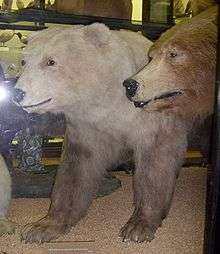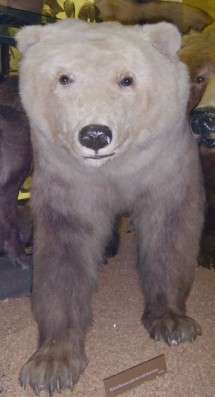Grizzly–polar bear hybrid


A 'grizzly–polar bear hybrid (also pizzly bear, polizzly,'grolar bizzly',', prizzly bear, pizzly-grizzly, nanulak, Polar-Grizz, or grolar bear[1][2]) is a rare ursid hybrid that has occurred both in captivity and in the wild. In 2006, the occurrence of this hybrid in nature was confirmed by testing the DNA of a unique-looking bear that had been shot near Sachs Harbour, Northwest Territories on Banks Island in the Canadian Arctic.[3]
Possible wild-bred polar bear-grizzly bear hybrids have been reported and shot in the past, but DNA tests were not available to verify the bears' ancestry.
Analyses of DNA sequences of bears have recovered multiple instances of introgressive hybridization between various bear species,[4][5][6] including introgression of polar bear DNA into brown bears during the Pleistocene.
Occurrences in the wild
With many suspected sightings and three confirmed cases,[7] theories of how such hybrids might naturally occur have become more than hypothetical. Although these two species are genetically similar and often found in the same territories, they tend to avoid each other in the wild. They also fill different ecological niches.
Grizzlies (and also Kodiak bears and "Alaskan brown bears", which are all subspecies of the brown bear, Ursus arctos), tend to live and breed on land. Polar bears prefer the water and ice, usually breeding on the ice.
The yellowish-white MacFarlane's bear, a mysterious animal known only from one specimen acquired in 1864, seems to attest that grizzly-polar bear hybrids may have always occurred from time to time. Another theory suggests that the polar bears have been driven southward by the melting of the ice cap, bringing them into closer contact with grizzly bears.
2006 discovery
Jim Martell, a hunter from Idaho, found and shot a grizzly–polar bear hybrid near Sachs Harbour on Banks Island, Northwest Territories reportedly on 16 April 2006.[1][3] Martell had been hunting for polar bears with an official license and a guide, at a cost of $45,450,[8] and killed the animal believing it to be a normal polar bear. Officials took interest in the creature after noticing that while it had thick, creamy white fur typical of polar bears, it also had long claws, a humped back, a shallow face, and brown patches around its eyes, nose, back, and foot, which are all traits of grizzly bears. If the bear had been adjudicated to be a grizzly, the hunter would have faced a possible CAN$1,000 fine and up to a year in jail.[9]
A DNA test conducted by Wildlife Genetics International in British Columbia confirmed it was a hybrid, with a polar bear mother and a grizzly bear father.[3] It is the first documented case in the wild,[10] though it was known that this hybrid was biologically possible and other ursid hybrids have been bred in zoos in the past.
Amidst much controversy, the bear has since been returned to Martell.[11][12]
2010 discovery
On 8 April 2010, David Kuptana, an Inuvialuit hunter from the nearby community of Ulukhaktok on Victoria Island shot what he thought was a polar bear. After inspecting the bear and having its DNA tested, it was discovered that the bear's mother was a grizzly-polar hybrid and the father was a grizzly bear. The Department of Environment and Natural Resources for the NWT said that it "...may be the first recorded second-generation polar-grizzly bear hybrid found in the wild".[13] The bear possesses physical characteristics intermediate between grizzlies and polar bears, such as brown fur on its paws, long claws, and a grizzly-like head.
2010 report
Biologists affiliated with the American Museum of Natural History and City College of the City University of New York have prepared a new report published in Canadian Field Naturalist that offers the first documented evidence that grizzlies are migrating into polar bear territory. Researchers found that seven grizzlies had been spotted in Wapusk National Park south of Churchill, Manitoba, between 2003 and 2008.[14][15]
Naming

Since the 2006 discovery placed the hybrid into the spotlight, the media have referred to this animal with several portmanteau names, such as pizzly, grolar bear,[16] and polizzly, but there is no consensus on the use of any one of these terms. Canadian wildlife officials have suggested calling the hybrid "nanulak", taken from the Inuit names for polar bear (nanuk) and grizzly bear (aklak).[17]
By one convention,[18] the name of the sire comes first in such combinations: the offspring of a male polar bear and a female grizzly would be the suggested nanulak or a "pizzly bear", while the offspring of a male grizzly and a female polar bear would be a "grolar bear" or possibly an aknuk. If the remains of MacFarlane's 1864 specimen—which was validly described according to ICZN rules—were traced and confirmed to be such a hybrid by ancient DNA techniques, the scientific name Ursus × inopinatus would be available for these animals.
Characteristics
Two grizzly–polar hybrid cubs (one female and one male) were born at Osnabrück Zoo in Osnabrück, Germany, in 2004, and their physical traits are generally an intermediate between the polar bear and the grizzly bear.[19] For example, their bodies are smaller than polar bears, but larger than grizzlies, while their heads fall between the broader grizzly head and the leaner polar bear head.[19] They have long necks like polar bears, but small shoulder humps like grizzlies.[19] The soles of their feet are partially covered in hair; polar bears have hair-covered soles, which act as insulation, and grizzlies have hairless soles.[19]
Similarly, the hair of the hybrids exhibits a pattern of hollowness, which blends the traits of both polar bears and grizzlies. In cross section, the hair of polar bears is hollow, while the hair of grizzlies is either solid or has small hollow regions.[19] This varies according to which part of the grizzly the hair is located.[19] In the hybrid male, the paw hair was solid, but the dark back hair was somewhat hollow, albeit with "smaller empty regions than found in polar bear hair".[19] The hair of the female hybrid, "contains a range of hollow regions".[19]
The hybrids demonstrated behavior more similar to polar bears than grizzlies. They stomped toys similar to how polar bears break ice, and hurled bags to the side "as polar bears may hurl prey".[19] Grizzlies given the same bags do not demonstrate this hurling behavior.[19] The hybrids were also observed lying down similar to polar bears: on their bellies with rear legs splayed.[19]
References
- 1 2 James Mallet (2008). "Hybridization, ecological races and the nature of species: empirical evidence for the ease of speciation" (PDF). Phil. Trans. R. Soc. B. 363 (1506): 2971–2986. doi:10.1098/rstb.2008.0081. PMC 2607318
 . PMID 18579473.
. PMID 18579473. - ↑ Anthony D. Barnosky (2009). Island Press, ed. Heatstroke: Nature in an Age of Global Warming. ISBN 1-59726-197-1.
- 1 2 3 "Wild find: Half grizzly, half polar bear: Hunter bags what expert 'never thought would happen' in wild". MSNBC.MSN.com. May 11, 2006. Retrieved 2006-05-14.
- ↑ Verena E Kutschera, Tobias Bidon, Frank Hailer, Julia L. Rodi, Steven R. Fain, Axel Janke (2014) Bears in a Forest of Gene Trees: Phylogenetic Inference Is Complicated by Incomplete Lineage Sorting and Gene Flow. Molecular Biology and Evolution 31(8): 2004–2017. doi:10.1093/molbev/msu186
- ↑ Frank Hailer, Verena E. Kutschera, Björn M. Hallström, Denise Klassert, Steven R. Fain, Jennifer A. Leonard, Ulfur Arnason, Axel Janke (2012): Nuclear Genomic Sequences Reveal that Polar Bears Are an Old and Distinct Bear Lineage. Science Vol. 336 no. 6079: 344-347. doi:10.1126/science.1216424
- ↑ Miller W, Schuster SC, Welch AJ, Ratan A, Bedoya-Reina OC, Zhao F, Kim HL, Burhans RC, Drautz DI, Wittekindt NE, Tomsho LP, Ibarra-Laclette E, Herrera-Estrella L, Peacock E, Farley S, Sage GK, Rode K, Obbard M, Montiel R, Bachmann L, Ingólfsson O, Aars J, Mailund T, Wiig O, Talbot SL, & Lindqvist C (2012). Polar and brown bear genomes reveal ancient admixture and demographic footprints of past climate change. Proceedings of the National Academy of Sciences of the United States of America, 109(36):E2382–E2390. doi:10.1073/pnas.1210506109
- ↑ "Alien Ice Bear" UK Channel 5 TV Documentary
- ↑ "Polar Bear / Grizzly Bear Crossbreed Hydrid". Blackbearheaven.com. Retrieved 2011-03-09.
- ↑ "Hunter Shoots Hybrid Bear". Fox News. Associated Press. 2006-05-12. Retrieved 2006-06-18.
- ↑ "Polar bear or Grizzly - how about Pizzly?". IOL. May 10, 2006. Retrieved 2006-05-14.
- ↑ "Rare hybrid bear comes to Idaho...as a trophy". Associated Press. 2007-01-21. Archived from the original on 2007-09-27. Retrieved 2007-01-21.
- ↑ Alicia P.Q. Wittmeyer Rare hybrid bear coming to Reno hunting show Tahoe Daily Tribune, January 19, 2007
- ↑ "Bear shot in N.W.T. was grizzly-polar hybrid". Cbc.ca. 2010-04-30. Retrieved 2011-03-09.
- ↑ Walton, Doreen (2010-02-24). "BBC: Grizzlies encroach on polar bear territory". BBC News. Retrieved 2011-03-09.
- ↑ "Grizzly Bears Move Into Polar Bear Habitat in Manitoba, Canada". Science Daily. 2010-02-23. Retrieved 2011-03-09.
- ↑ Hunter may have shot grolar bear – or was it pizzly? at the Wayback Machine (archived May 25, 2006), CBC North, 26 April 2006.
- ↑ "Hybrid bear shot dead in Canada". BBC Science. 13 May 2006.
- ↑ Naming Conventions A semi-scientific reference for hybrid naming conventions, with specific examples of big-cat hybrids.
- 1 2 3 4 5 6 7 8 9 10 11 Walker, Matt (30 October 2009). "Polar bear plus grizzly equals?". BBC News Online. Retrieved 30 October 2009.
External links
- CBC Article
- CBC News Story
- Wild find: Half grizzly, half polar bear - Msn.com
- Hybrid Bears
- The North This Week (MP3) (CBC podcast including interviews with scientist Ian Stirling, guide Roger Kuptana, and hunter Jim Martell)
- National Geographic Article
- Wildlife Genetics International